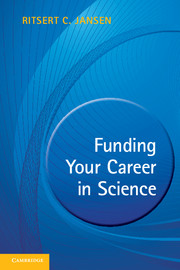5 - Support
Published online by Cambridge University Press: 05 August 2013
Summary
“When the student is ready, the teacher will appear.”
Buddhist proverbIntroduction
Time to go for victory. Time to submit your proposal. No, wait a moment; you should first ask people with experience to criticize and professionalize all your application’s components: from language to utilization, from idea to work plan to budget. Listen carefully to their feedback and attend to all the potential weaknesses, if not flaws, in your proposal. You can be sure that the funding agency will send your proposal out for review to senior peers, collect their critiques, possibly confront you with their points, and then decide on your proposal: go or no-go. And the no-go will hurt, especially if you realize you could have prevented some of the criticism in advance, if only you’d known. So, take time to organize getting feedback before submission and take what is being said seriously, very seriously: use other people’s talents, benefit from whatever coaching, mentoring, and training is available as much as you can!
Mentoring. Can help from experienced scientists (grant laureates) make the difference? The answer seems to be almost too obvious. Contact potential mentors, even if they appear highly intimidating to you!
Coaching. Are you an expert on budgets, intellectual property protection, marketing, or other non-scientific tasks? Or do you want to become such an expert? Probably not. So seek some coaching to save time and equally advance the quality of your proposal! But where do you find these people?
Training. How about training on the job? You simply write, submit, fail, learn, revise, resubmit, and so on. This is an extensive and painful training program! Taking tailored courses may help you speed up the process.
Information
- Type
- Chapter
- Information
- Funding your Career in ScienceFrom Research Idea to Personal Grant, pp. 170 - 191Publisher: Cambridge University PressPrint publication year: 2013
